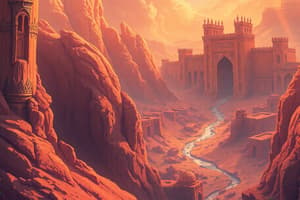Podcast
Questions and Answers
What is the significance of Ahmad ibn Majid in maritime history?
What is the significance of Ahmad ibn Majid in maritime history?
- He was a famous Persian philosopher.
- He contributed to the fields of mathematics and physics.
- He invented the magnetic compass.
- He was known as the Lion of the Sea due to his navigation expertise. (correct)
Which invention is associated with the advancements in sea-faring during the Abbasid period?
Which invention is associated with the advancements in sea-faring during the Abbasid period?
- Sailing ship
- Printing press
- Astrolabe (correct)
- Pinhole camera
Where did Ibn Battuta travel extensively during his explorations?
Where did Ibn Battuta travel extensively during his explorations?
- From Baghdad to Constantinople
- From Mecca to Medina
- From Spain to India
- From North Africa to China (correct)
Who was known for the development of algebra and is often credited with the introduction of the term 'al-jibra'?
Who was known for the development of algebra and is often credited with the introduction of the term 'al-jibra'?
What was the primary motivation behind Marco Polo's travels?
What was the primary motivation behind Marco Polo's travels?
Flashcards are hidden until you start studying
Study Notes
Geography and Regions
- The Pyrenees: A mountain range forming a natural border between Spain and France.
- Iberian Peninsula: Located in southwestern Europe; includes Spain and Portugal.
- Maghreb: A region in North Africa including Morocco, Algeria, Tunisia, and Libya.
- Ifriqiya: Historically refers to the eastern part of the Maghreb, particularly Tunisia.
- Sahara: The largest hot desert in the world, spanning several North African countries.
- Egypt: Northeastern African country known for its ancient civilization and monuments.
- Arabian Peninsula: A large peninsula in Southwest Asia including Saudi Arabia and neighboring countries.
- Arabian Desert: Dominant desert within the Arabian Peninsula.
- Jerusalem: A city of religious significance for Judaism, Christianity, and Islam.
- Damascus: The capital of Syria, one of the oldest continuously inhabited cities in the world.
- Mecca: Holiest city in Islam, located in Saudi Arabia, and the site of Hajj pilgrimage.
- Medina: Second holiest city in Islam, also in Saudi Arabia, where Muhammad is buried.
- Baghdad: Capital of Iraq, historically significant as a center of learning and culture during the Abbasid Caliphate.
- Constantinople: Modern-day Istanbul, significant historical crossroads between Europe and Asia.
- Caucasus: A region located between the Black Sea and the Caspian Sea, containing diverse cultures and languages.
- Black Sea: An inland sea bordered by several countries, linking Europe and Asia.
- Mediterranean Sea: A sea connected to the Atlantic Ocean, crucial for trade and cultural exchange.
- Red Sea: A seawater inlet of the Indian Ocean, separating Africa from the Arabian Peninsula.
- Arabian Sea: Part of the Indian Ocean, bordered by India, Arabia, and Africa.
- Persian Gulf: A shallow body of water between the Arabian Peninsula and Iran.
- Hindu Kush: A mountain range in Central and South Asia, extending through Afghanistan and northwestern Pakistan.
- Himalayas: The highest mountain range in the world, home to Mount Everest, spanning five countries including Nepal and India.
Important Historical Figures
- Ahmad ibn Majid: Renowned Omani navigator and cartographer, known for his work in maritime navigation.
- Jabbir ibn Hayyan: A prominent Persian alchemist and chemist, often referred to as the father of chemistry.
- Hasan ibn Haytham: An Arab scientist known as the "father of optics" for his discovery of the principles of the pinhole camera.
- Muhammad ibn Musa Khwarizmi: Mathematician and astronomer recognized for his work on algebra; introduced the concept of algorithms.
Key Maritime Inventions
- Kamal: An ancient navigational device used to determine latitude.
- Canon: Significantly advanced artillery weapon used in maritime conflicts.
- Astrolabe: An instrument used to make astronomical measurements.
- Magnetic Compass: Essential for navigation, allowing sailors to determine north.
- Caravel: A small, highly maneuverable sailing ship used by explorers during the Age of Discoveries.
Explorers and Their Journeys
- Marco Polo: Traveled from Venice to China, promoting trade and exchange of knowledge along the Silk Road.
- Ibn Battuta: A Moroccan explorer who journeyed extensively, including a significant pilgrimage to Mecca.
- Zheng He: A Chinese admiral who led voyages to Southeast Asia and beyond, establishing trade routes and contacts.
Fun Facts
- Abul-Abbas: An Asian elephant gifted to Charlemagne by the Abbasid caliph Harun al-Rashid, symbolizing diplomatic relations between the Abbasid and Carolingian empires.
Studying That Suits You
Use AI to generate personalized quizzes and flashcards to suit your learning preferences.




